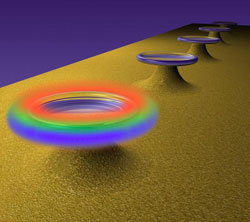"On-the-fly" spectroscopy with a diode laser and a frequency comb

Light confinement in microcavities: Quartz glass microresonators on a silicon chip allow to store light for long times corresponding to more than 1 million round trips of photons within the resonator. Depending on its wavelengths (color), the light is confined closer to the rim or more inside the resonator, respectively.<br>
The research field of optical spectroscopy has already attracted attention of generations of scientists, starting with Fraunhofer's discovery of dark lines in the sun spectrum in 1814 followed by the work of Kirchhoff and Bunsen in 1859 explaining these lines as absorption of light in atoms and molecules.
Within the last decade, the invention of optical frequency combs has revolutionized the field of spectroscopy and enabled measurements with previously unattainable precision. Now, MPQ scientists (from the “Laboratory of Photonics & Quantum Measurements” lead by EPFL tenure track professor T.J. Kippenberg) developed a novel measurement scheme for broadband and fast measurements of optical spectra utilizing the accuracy of an optical frequency comb and transferring it to an easy-to-use tunable diode laser. (Nature Photonics, AOP, August 2009, DOI:10.1038/nphoton.2009.138)
These tunable diode lasers can be swept in frequency (i.e. the “color” of the laser can be changed) to measure the spectral response of anything of interest, for example light absorption in gases but also the response of photonic elements in the growing field of nano-photonics. However, sweeping the frequency of a tunable diode laser alone does not allow for precise spectroscopic measurements, unless the instantaneous frequency of the diode laser at a certain time is known precisely.
Here, the new measurement scheme comes into play, enabling an “on-the-fly” calibration of the sweeping diode laser using an optical fiber laser based frequency comb. The achieved precision of the spectroscopic measurement is better than 1 MHz (note that the frequency of the laser light is around 200 THz, corresponding to a relative accuracy of 5×10 to the -9).
As a first application, the newly developed spectroscopy scheme has been used by MPQ scientists Pascal Del'Haye and Dr. Arcizet to obtain absorption spectra of on-chip monolithic optical microresonators made of fused silica (so called microtoroids). These measurements allowed for the first time to analyze dispersion properties of these devices (conventional spectroscopy methods had so far failed due to the extremely narrow (sub-MHz) absorption lines of the microresonators). Numerical simulations as well as the experimental results show that the mode structure of microtoroids is extremely uniform, i.e. the optical modes that are supported by the device are nearly spaced equidistant. This surprising result is a consequence of the spatial shape of the optical modes within the resonator (leading to “red” modes at low frequencies being more confined inside the resonator than “blue” modes at high frequencies) that is partly compensated by a different material dispersion for different light frequencies (here, the “red” modes are travelling slower, i.e. the resonator seems to be larger for the “red” modes). “The small total dispersion of microtoroids makes them a well suited device for applications in microphotonics as well as for frequency comb generation via nonlinear optical
frequency conversion”, states Prof. Tobias Kippenberg.
A patent of the new technique has been filed together with Max Planck Innovation. [PD] / Olivia Meyer-Streng
Original Publication:
P. Del'Haye, O. Arcizet, M. L. Gorodetsky, R. Holzwarth & T. J. Kippenberg
Frequency comb assisted diode laser spectroscopy for measurement of microcavity dispersion
Nature Photonics, Advance Online Publication, August 2009, DOI:10.1038/nphoton.2009.138
Nature Photonics “News and Views”, T. Schibli, Colorado University, USA
Optical spectroscopy: Clever calibration, doi:10.1038/nphoton.2009.150
Contact:
Prof. Dr. Tobias Kippenberg
Ecole Polytechnique Fédérale de Lausanne, CH1015, Switzerland and
Max Planck Institute of Quantum Optics, 85748 Garching, Germany
Phone: +49 – 89 / 32905 727
Fax: +49 – 89 / 32905 200
e-mail: tobias.kippenberg@mpq.mpg.de
Pascal Del'Haye
Max Planck Institute of Quantum Optics
Phone: +49 – 89 / 32905 284
Fax: +49 – 89 / 32905 200
e-mail: pascal.delhaye@mpq.mpg.de
Dr. Olivia Meyer-Streng
Max Planck Institute of Quantum Optics
Press & Public Relations
Phone: +49 – 89 / 32905 213
Fax: +49 – 89 / 32905 200
e-mail: olivia.meyer-streng@mpq.mpg.de
Media Contact
More Information:
http://www.mpq.mpg.de/k-lab/All latest news from the category: Physics and Astronomy
This area deals with the fundamental laws and building blocks of nature and how they interact, the properties and the behavior of matter, and research into space and time and their structures.
innovations-report provides in-depth reports and articles on subjects such as astrophysics, laser technologies, nuclear, quantum, particle and solid-state physics, nanotechnologies, planetary research and findings (Mars, Venus) and developments related to the Hubble Telescope.
Newest articles

Properties of new materials for microchips
… can now be measured well. Reseachers of Delft University of Technology demonstrated measuring performance properties of ultrathin silicon membranes. Making ever smaller and more powerful chips requires new ultrathin…

Floating solar’s potential
… to support sustainable development by addressing climate, water, and energy goals holistically. A new study published this week in Nature Energy raises the potential for floating solar photovoltaics (FPV)…

Skyrmions move at record speeds
… a step towards the computing of the future. An international research team led by scientists from the CNRS1 has discovered that the magnetic nanobubbles2 known as skyrmions can be…





















